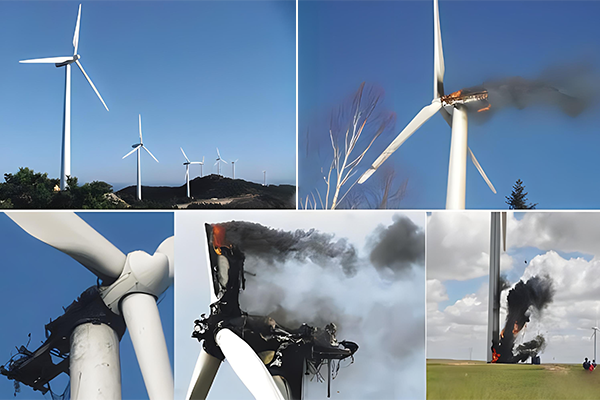Wind turbine fire failure and solution
Wind turbine fire faults has become a key force in the global transition towards sustainable and renewable energy. However, like any complex mechanical system, wind turbines also face various challenges.
One relatively uncommon but serious issue is the possibility of fires occurring within the turbine. In order to enhance the safety of wind turbines, it is important to first understand the common factors that can lead to fires and develop comprehensive solutions.

What causes wind turbines to catch fire?
There are diverse reasons why fires can occur in wind turbines, although it is worth noting that such events are relatively rare. Some common factors that may lead to fires in wind turbines include:
Mechanical failures
Components within the wind turbine, such as the gearbox or generator, can experience mechanical failures due to wear and tear, manufacturing defects, or improper maintenance. The friction and overheating of these components have the potential to ignite fires.
Electrical issues
Electrical faults, such as short circuits or problems with the electrical control system, can cause overheating and sparks, leading to fires. Lightning strikes are also a potential cause of electrical issues.
Generator overheating
The generator in a wind turbine can generate a significant amount of heat during operation. If the cooling system fails or is insufficient, it can result in overheating and, in extreme cases, fires.
Lightning strikes
Wind turbines are tall structures that are susceptible to lightning strikes. Direct strikes or nearby strikes can cause power surges, damage electrical components, and potentially lead to fires.
Hydraulic system failures
Wind turbines commonly employ hydraulic systems for various functions, such as blade adjustment. If there are leaks or failures in the hydraulic system, flammable hydraulic fluids can pose a fire risk.
Flammability of materials
Some components within wind turbines, such as the blades, are often made of composite materials. If these materials are not fire-resistant, they can contribute to the spread of fires.
What are the common solutions?
In order to deal with the common factors that can lead to wind turbine fires, various preventive measures and solutions can be implemented. Here are some suggested solutions:
Regular maintenance and inspection
Develop a strict maintenance plan to identify and resolve potential mechanical problems in a timely manner and prevent them from escalating.
Check gear boxes, generators, and other critical components regularly to detect wear and damage.
Upgrade electrical system
Install an advanced monitoring system that detects electrical problems in real time.
Implement a lightning protection system to minimize the risk of lightning damage to the electrical components of the unit.
Improved cooling system
Upgrade cooling systems for generators and other heat-producing components to prevent overheating.
Ensure proper ventilation and cooling in the cabin and other enclosed Spaces.
Lightning protection
Install a lightning protection system, such as a lightning rod, to direct lightning strikes away from critical components.
Use overvoltage protection to reduce the impact of power surges.
Hydraulic system maintenance
Implement regular inspection and maintenance of hydraulic system to detect and repair leakage problems in time.
Use flame-retardant hydraulic fluid to reduce the risk of fire in case of leakage.
Fireproof material
Flame-retardant materials are used in the manufacture of critical components, especially those that are susceptible to high temperatures.
Ensure that the composite materials used for blade fabrication are fire resistant.
Fire detection and suppression system
Install advanced fire detection systems in wind turbines.
Implement automatic fire suppression systems, such as sprinklers or foam systems, to quickly extinguish fires.
Emergency response planning
Develop and regularly update emergency response plans for wind turbine sites.
Provide training to personnel on how to respond to potential fire incidents.
Data monitoring and analysis
Use data analysis to continuously monitor the performance of wind turbines.
Implement predictive maintenance based on data analysis to resolve potential problems in a timely manner.
Compliance with safety regulations
Ensure compliance with industry standards and regulations related to wind turbine safety.
Keep abreast of advances in technology and safety standards and incorporate improvements into existing systems.
By combining these solutions, wind farm operators can improve the safety and reliability of wind turbines, reduce fire risk, and ensure the long-term sustainability of wind energy systems. The global wind energy industry’s relentless efforts at safety have resulted in a relatively low fire risk for wind turbines, and the industry as a whole has a good safety record.
Learn More:Fault analysis of wind turbines in China – ScienceDirect

